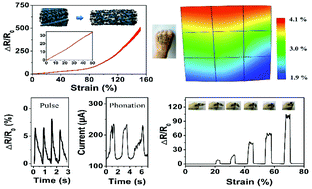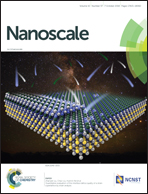Fibrous strain sensor with ultra-sensitivity, wide sensing range, and large linearity for full-range detection of human motion†
Abstract
It is challenging to construct exquisite microstructures for integrating extraordinary sensitivity, wide strain range detectability, low hysteresis, good linearity, and excellent reliability and stability in a single type of strain sensor. In this paper, we report a high-performance fibrous strain sensor with ultrahigh sensitivity (gauge factor up to 350), wide sensing range (0.1% to 150% strain), low hysteresis, good linearity over a large strain range (up to 50%), and excellent reliability and stability (>2000 cycles). Our fibrous strain sensor exhibits superior comprehensive properties to previous strain sensors, attributed to its hierarchical microstructure composed of twisted polyurethane fibers and microcracked poly(3,4-ethylenedioxythiophene):poly(4-styrenesulfonate) sensing layer on each fiber, bridged by carbon nanotube agglomerates. This sensor is attractive and promising for the full-range detection of human motion from subtle deformations to large movements. In addition, the spatial extensional strain distribution of human skin can also be detected by the sensing fabric woven by this fibrous sensor due to its knittability.



 Please wait while we load your content...
Please wait while we load your content...